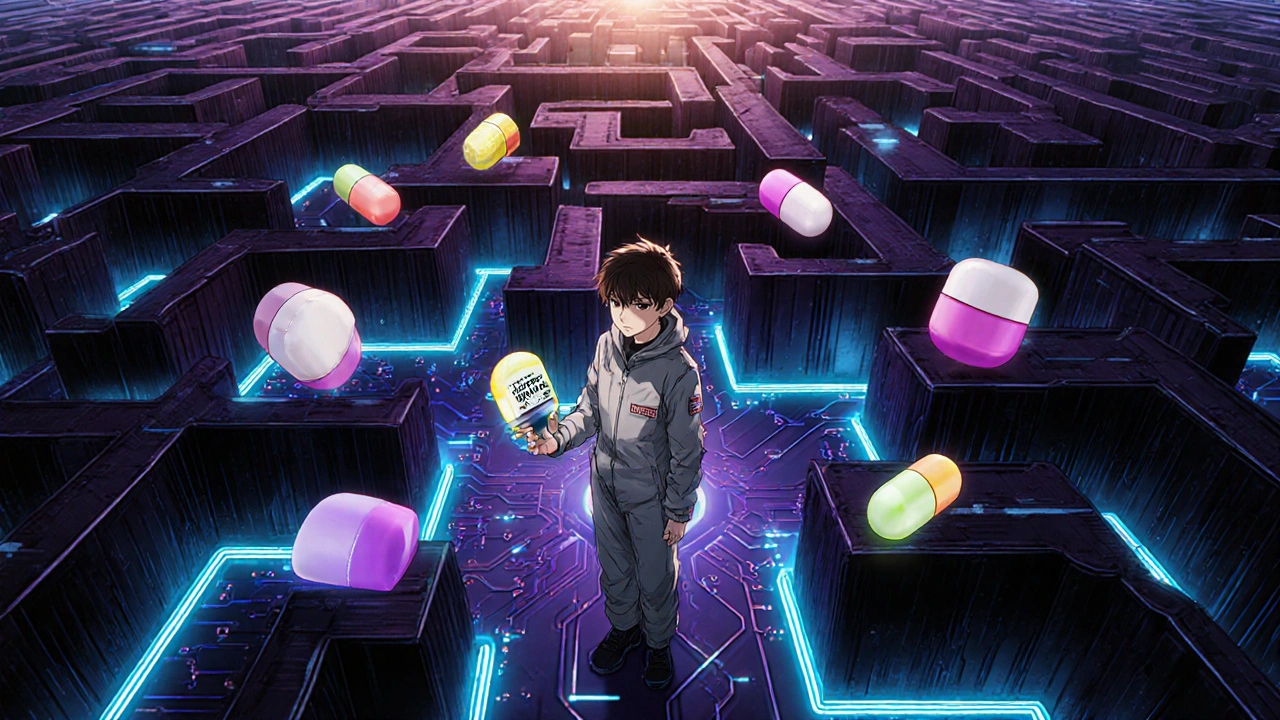Choosing the right treatment for ADHD can feel like a maze. One pill, Strattera, often shows up as a non‑stimulant option, but how does it really stack up against the more common stimulants and the newer non‑stimulant choices? This guide walks you through the key differences, so you can decide whether Strattera or another drug fits your lifestyle, health profile, and budget.
Strattera (Atomoxetine) is a prescription medication classified as a selective norepinephrine reuptake inhibitor (NRI). Unlike stimulants that boost dopamine and norepinephrine, Strattera mainly increases norepinephrine levels by blocking its reabsorption in the brain. This mechanism gives it a slower onset, a lower abuse potential, and a distinct side‑effect profile.How Strattera Works and What to Expect
Strattera’s active ingredient, Atomoxetine, targets the norepinephrine transporter. By keeping more norepinephrine available, it helps improve attention, impulse control, and hyperactivity in many patients. The drug usually starts at 40 mg once daily for adults, with doses escalating to 80-100 mg based on weight and response. Because it isn’t a stimulant, you won’t feel the immediate “boost” that drugs like Adderall provide. Instead, noticeable improvements often appear after 2-4 weeks, and full benefits may take up to 8 weeks.
Common side effects include dry mouth, loss of appetite, insomnia, and occasional stomach upset. A small percentage of users report mood changes or increased suicidal thoughts, especially in teens, so regular monitoring is essential.
Top Alternatives to Strattera
When doctors talk about “alternatives,” they usually mean two broad groups: stimulants and newer non‑stimulants. Below are the most frequently prescribed options.
- Adderall (mixed amphetamine salts) - a classic stimulant that raises both dopamine and norepinephrine. Fast onset (30‑60 min) and short to medium duration (4‑6 hours).
- Ritalin (methylphenidate) - another stimulant that blocks dopamine reuptake. Often used in short‑acting (3‑4 hours) and extended‑release (8‑12 hours) forms.
- Vyvanse (lisdexamfetamine) - a pro‑drug that converts to dextroamphetamine in the body, offering a smoother, longer‑lasting effect (10‑14 hours).
- Intuniv (guanfacine extended‑release) - a non‑stimulant that works on alpha‑2A receptors, mainly used when anxiety co‑exists with ADHD.
- Kapvay (clonidine extended‑release) - another alpha‑2 agonist, useful for sleep‑related ADHD symptoms.
Side‑by‑Side Comparison
| Drug | Class | Mechanism | Typical Dose | Onset | Duration | Common Side Effects | Abuse Potential | Best For |
|---|---|---|---|---|---|---|---|---|
| Strattera (Atomoxetine) | Non‑stimulant | Norepinephrine reuptake inhibition | 40‑100 mg daily | 2‑4 weeks | 24 hours (once‑daily) | Dry mouth, insomnia, GI upset, mood swings | Low | Patients with substance‑use risk or need for once‑daily dosing |
| Adderall | Stimulant | Amphetamine‑mediated dopamine & norepinephrine release | 5‑30 mg 1‑2×/day | 30‑60 min | 4‑6 hours (IR) / 12 hours (XR) | Appetite loss, insomnia, jitteriness, increased BP | High | Quick symptom control; patients without substance‑use concerns |
| Ritalin | Stimulant | Methylphenidate blocks dopamine reuptake | 5‑20 mg 2‑3×/day | 20‑40 min | 3‑4 hours (IR) / 8‑12 hours (XR) | Headache, stomach pain, anxiety, growth suppression | High | Patients needing adjustable dosing throughout the day |
| Vyvanse | Stimulant (pro‑drug) | Lisdexamfetamine converts to dextroamphetamine | 30‑70 mg daily | 1‑2 hours | 10‑14 hours | Dry mouth, weight loss, irritability, insomnia | Medium‑High | All‑day coverage with low peaks; adults/teens who need stable control |
| Intuniv | Non‑stimulant | Alpha‑2A agonist - reduces norepinephrine release | 1‑4 mg daily | 1‑2 weeks | 24 hours | Drowsiness, fatigue, low BP, dizziness | Low | Patients with comorbid anxiety or who can’t tolerate stimulants |
| Kapvay | Non‑stimulant | Alpha‑2 agonist - similar to clonidine | 0.1‑0.4 mg daily | 1‑2 weeks | 24 hours | Sleepiness, dry mouth, constipation, low BP | Low | Kids with sleep problems or tics alongside ADHD |

When to Choose Strattera Over Stimulants
- Substance‑use or abuse risk: Because Strattera isn’t a controlled substance, it’s safer for patients with a history of drug misuse.
- Need for once‑daily dosing: The 24‑hour coverage eliminates mid‑day dosing gaps that can happen with short‑acting stimulants.
- Co‑existing anxiety or tic disorders: Stimulants can worsen anxiety; Strattera’s calmer profile may be preferable.
- Adverse reactions to stimulants: If appetite loss, severe insomnia, or cardiovascular spikes are an issue, a non‑stimulant switch can improve tolerance.
- Pregnancy planning: While no medication is risk‑free, Strattera’s lower abuse potential makes it a common choice when clinicians need a non‑stimulant option.
When Stimulants Might Be Better
If you need rapid symptom relief, have no substance‑use concerns, and can handle the typical side‑effects, a stimulant often provides stronger, faster control. Vyvanse’s smooth, long‑acting profile is especially popular among adults who dislike dose‑timing hassles. Short‑acting formulations of Adderall or Ritalin let doctors fine‑tune coverage for school or work schedules.
Cost & Insurance Landscape in Australia (2025)
- Strattera: Approx. AU$105 for a 30‑day supply (generic Atomoxetine). Most PBS listings cover ~70 % of the cost for eligible patients.
- Adderall (mixed amphetamine salts) - not listed on PBS; out‑of‑pocket ~AU$180 for 30 days.
- Ritalin (methylphenidate) - PBS‑subsidised, around AU$85 per month.
- Vyvanse - PBS‑listed for certain severe cases; typical cost AU$210/month.
- Intuniv/Kapvay - PBS‑covered for children under 12, costing about AU$70/month.
Check your private health fund’s formulary; many funds treat non‑stimulants and stimulants differently in co‑pay structures.

Practical Tips for Switching or Adding a Medication
- Gradual taper: When moving from a stimulant to Strattera, taper the stimulant over 1‑2 weeks to avoid rebound hyperactivity.
- Monitor blood pressure: Both stimulants and non‑stimulants can affect BP; schedule a check after the first dose change.
- Watch for mood changes: Especially in teens, track any emergence of depressive thoughts for at least 4 weeks.
- Meal timing: Take Strattera with food to reduce stomach upset; avoid high‑fat meals right before a stimulant dose.
- Consistency is key: Take the same dose each day, same time, to maintain steady blood levels.
Quick Decision Checklist
- Do you have a history of substance misuse? → Consider Strattera.
- Do you need rapid symptom control for exams or presentations? → Stimulant (Adderall, Ritalin, Vyvanse).
- Is anxiety or a tic disorder part of your picture? → Non‑stimulant options (Strattera, Intuniv, Kapvay).
- Are you looking for once‑daily dosing? → Strattera or Vyvanse.
- Is cost a major factor? → Check PBS listings; Strattera and Ritalin are usually cheaper.
Frequently Asked Questions
Can I take Strattera and a stimulant at the same time?
Yes, some doctors prescribe a combination when a single drug doesn’t fully control symptoms. The stimulant handles fast‑acting needs while Strattera provides steady coverage. Close monitoring is required to avoid excessive heart‑rate elevation.
How long does it take for Strattera to start working?
Most patients notice a modest improvement after 2‑4 weeks; full therapeutic effect may take up to 8 weeks. Patience is key, and dose adjustments can speed up response.
Is Strattera safe for children?
The drug is approved for children 6 years and older. Side‑effects such as appetite loss and sleep issues are more pronounced in younger kids, so regular growth monitoring is advised.
What should I do if I miss a dose of Strattera?
Take the missed dose as soon as you remember, unless it’s within 6 hours of the next scheduled dose. In that case, skip the missed one and continue with your regular schedule. Never double‑dose.
Are there any dietary restrictions with Strattera?
No strict restrictions, but taking the pill with a full glass of water and food can lessen stomach upset. Avoid excessive caffeine if you’re also on a stimulant.
Whether you end up on Strattera, a stimulant, or a newer non‑stimulant, the right choice hinges on your health history, daily routine, and personal preferences. Talk openly with your prescriber, keep a symptom diary, and revisit the plan every few months. That way you’ll land on a medication combo that keeps you focused and feeling good.

Jameson The Owl
October 19, 2025 AT 17:48Strattera presents a non‑stimulant pathway that many overlook. The pharmaceutical industry conceals the fact that its norepinephrine focus aligns with hidden neural control experiments. Governments quietly sponsor trials that test long‑term cognitive dampening under the guise of ADHD treatment. The delayed onset of Stratomax, the unofficial code name, allows data collection before patients notice any effect. This latency is deliberately engineered to mask subtle mood alterations that could be useful for population monitoring. Meanwhile, stimulant alternatives such as Adderall provide rapid dopamine spikes that are easier to track. The distinction between the two classes becomes a tool for selective surveillance of high‑risk individuals. Patients with a history of substance misuse are steered toward Strattera, not merely for safety but to keep them on a predictable pharmacological schedule. Insurance formulary listings are manipulated so that non‑stimulants appear cheaper, encouraging broader adoption. The cost advantage also serves to funnel public health budgets into a controlled supply chain. Clinical guidelines published by reputable journals omit the potential for covert behavioral conditioning. Physicians are often unaware that the long‑acting formulation can be paired with hidden micro‑dosing protocols. The fact that Strattera is not a controlled substance reduces scrutiny from law enforcement agencies. This legal loophole is exploited by shadow networks that market off‑label uses. Ultimately, the choice between Strattera and stimulants is less about symptom relief and more about who holds the data. Individuals must remain vigilant and demand full transparency from prescribers and regulators alike.
James Dean
October 24, 2025 AT 22:48The article nails the basics without any fluff.
Ankitpgujjar Poswal
October 30, 2025 AT 03:48If you're wrestling with ADHD meds, don't settle for the first prescription you get. Strattera can be a solid foundation, especially if you fear dependence. Make sure you track your energy and mood daily; consistency is your ally. Push yourself to communicate any side effects to your doctor immediately.
Bobby Marie
November 4, 2025 AT 08:48Your point hits hard, just remember the brain needs time to adapt.
Christian Georg
November 9, 2025 AT 13:48When switching from a stimulant to Strattera, a gradual taper is essential to avoid rebound hyperactivity.
Start reducing the stimulant dose by 10‑20 % every few days while monitoring blood pressure.
A low‑dose breakfast of Strattera can smooth the transition, but keep an eye on appetite changes.
Most patients report stable focus within four weeks if they follow a structured plan 😊.
Never skip the follow‑up appointment, as dose adjustments may be necessary.
Christopher Burczyk
November 14, 2025 AT 18:48While your guidance is thorough, it omits the necessity of baseline cardiac evaluation prior to any pharmacological alteration.
The recommendation to taper stimulants without a cardiology consult may expose patients to undue risk.
Practitioners should incorporate ECG monitoring into the standard protocol.
Nicole Boyle
November 19, 2025 AT 23:48From a pharmacodynamic perspective, Atomoxetine's selective norepinephrine reuptake inhibition yields a distinct therapeutic index.
Its half‑life of approximately 5 hours, extended via hepatic CYP2D6 metabolism, informs dosing schedules.
Clinicians must consider genotype‑guided dosing to mitigate interindividual variability.
In contrast, amphetamine‑based agents exhibit rapid peak plasma concentrations, necessitating split dosing for optimal coverage.
Caroline Keller
November 25, 2025 AT 04:48Oh, the sheer drama of a molecule deciding your destiny!
I can already hear the inner monologue screaming, 'Will I finally focus or will my appetite vanish forever?'
The stakes feel like a soap opera, and the side‑effects are the plot twists we never asked for.
Felix Chan
November 30, 2025 AT 09:48Hey folks, great rundown! If you're new to this, just pick what feels right and give it time. You’ll find your groove sooner than you think.
ashanti barrett
December 5, 2025 AT 14:48I hear you; trying a new medication can feel overwhelming, but you’re not alone.
Keep a simple journal of how you feel each day, and share it with your doctor.